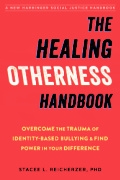As our nation’s children return to school, what sits with me is a need to talk frankly about the impact that school bullying, exclusion, humiliation, and other actions have on child development. The kids who are different, outcasts, Other bear the legacy of social pain. This doesn’t have to be the case, and parents’ awareness about the impact of bullying and how to recognize and respond to it can prevent problems from developing later in life.
For many adults, being cast as Other during childhood had a long-lasting impact on our social development, with legacies of never feeling good enough still reflected in our self-esteem and the beliefs we hold about who we are and what we deserve in relationships. We came to believe that we were “less than” during pivotal moments as the only child who was Black/gay/poor/non-Protestant in our school, because we were very fat or very short, or because we learned to read and write differently from other children. Sometimes we were highly sensitive or introverted children, and therefore easy to target. We were the kids who were conspicuously different, and the people around us never let us forget it.
Indeed, our stories of Otherness are many. As it was with us, there is danger that it will be for children today; yet it doesn’t have to be.
The good news is that we’re talking more and more about this stuff. Many schools have made strides in protecting individuals and groups who were previously targeted, offering infinitely more resources for LGBTQ youth, for example, from what even existed a decade ago when I was presenting on this stuff to school counselors in Texas. I’m grateful to everyone who’s made it easier for these kids to stay in school and who’s been active in addressing the high incidence of depression, drug abuse, and suicide among this population.
Even in my gratitude, I wonder about those children whose experiences aren’t represented by concerted advocacy efforts. What happens for the child whose conspicuous differences aren’t part of a protected group? I maintain that as important as it is to continue the good fight for LGBTQ youth, the effort must extend to address a broader set of bullying behaviors for the children who are outcast for other circumstances.
I’ve come to view school bullying as a general cluster of activity that are willfully carried out by others to punish a child for some aspect of her or his being. Certainly, this includes the obvious forms of bullying like physically shoving a child, name calling, or practical jokes that aim to humiliate. It also includes use of social media to send denigrating and hate-based messages. Less obvious but also potent methods include willful exclusion from group activities, malicious gossip about a child, and picking a child last for a team in gym class. Sometimes, teachers are active participants in publicly shaming a child (teachers, check yourselves on this. When you dislike a child or parent, seek support to ensure that this isn’t coming across in how you teach or discipline).
It’s with these thoughts in mind that I offer the following points for parents in protecting children from school bullying:
- Talk to your child about the school’s social climate, paying attention to discussions of friends old and new. Who’s coming and going in your child’s life, and how?
- Be aware of your child’s use of media as a tool for communication with peers. What’s new and now, and how does it work? Who else is using the platform in addition to your child’s age group?
- Look for subtle changes in behavior that aren’t attributable to other issues you’re aware of in the child’s environment.
- Notice the child’s relative anxiety about separation from you. Is the child becoming more clingy or requiring more attention in spite of no changes in the home?
- Be aware of compounding effects that home life has in school functioning. If the child begins misbehaving because of a family divorce for example, the acting out at school may lead to a teacher humiliating the child in the classroom as a form of behavior control. Humiliation creates its own set of problems and can be especially traumatic for a child who’s already experiencing upheaval at home.
- Talk to the teachers and school counselors when you see changes happening in your child’s life. Work with them to get buy-in for the protection of your child. Don’t accept anything other than a full commitment to your child’s safety.
- Talk with other parents in a non-defensive way about the general problem of school bullying and seek buy-in by inviting them to consider “If this was your child who’s bullied, what would you want?”
- If problems persist, or if the teacher or school administration is in fact contributing to a child’s problems in school, seek a therapist who specializes in work with children. A therapist can not only help identify the sources of a child’s problems and provide treatment in response, but can also let you know of community resources that might benefit you and your child. The Association for Play Therapy is a great resource for locating a therapist who specializes in work with children: http://www.a4pt.org/
- Above all, make time and listen to your child. Be flexible with the changes that occur during development. Having a home that’s a physical and emotional refuge from whatever is happening in the world is a significant factor in providing for healthy child development.

